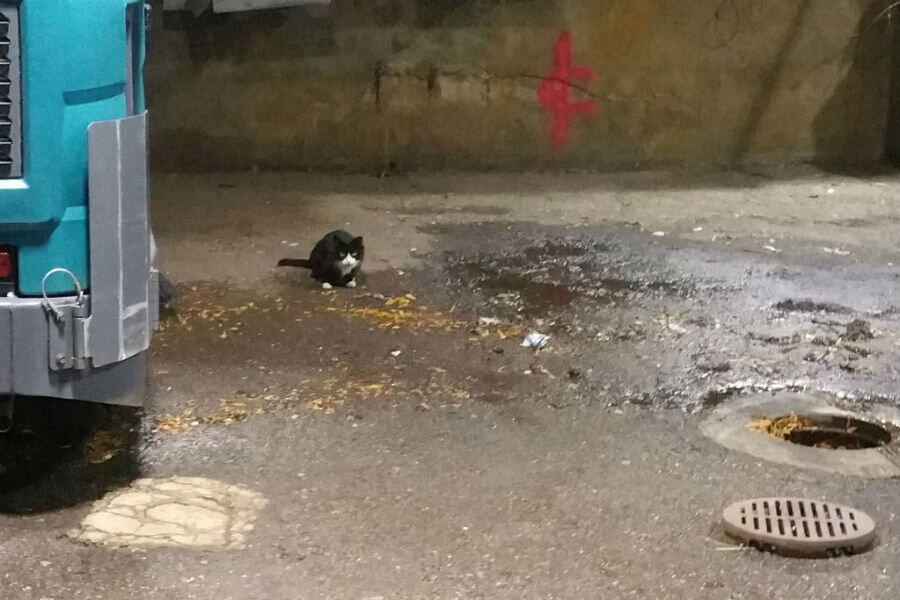Can feral cats be useful in the war on rats?
Loading...
Feral cats can be trouble. Critics say they spread diseases and threaten local wildlife populations. But one New York City group hopes a program that puts the cats to work will be the answer: both for the cats and for the city’s rat infestation.
Volunteers with the New York City Feral Cat Initiative trap groups – or "colonies" – of wild cats, neuter and vaccinate them, and return them to the streets. Some cat colonies have been causing trouble in local communities. Others are threatened by construction in the constantly evolving city. When the cats can’t be returned to their former stomping-grounds, the volunteers re-home them to areas where rats roam.
Some critics say that feral cats are an ineffective long-term solution to the rat problem. Others worry about endangering local wildlife, since cats have been know to prey on birds, chipmunks, and rabbits.
But proponents argue that deploying feral cats is the only thing that works. New York invested another $2.9 million in rat eradication efforts this summer, the latest in a string of more than 80 ineffective programs. Is a traditional solution still the best one?
“We used to hire exterminators, but nature has a better solution,” Rebecca Marshall, sustainability manager at the Jacob K. Davits Convention Center, told the Associated Press. “And cats don’t cost anything.”
Rats, attracted by garbage and food deliveries, have plagued the convention center for years. For the past two years, four feral cats have made the area their home – and the rats have mostly stayed away.
Rats are a considerable problem, especially in the aging cities of the East Coast. In New York alone, there are between 2 and 8 million rats. The Center for Disease Control warns that they can spread over 35 diseases worldwide. Low-income families – who live in areas of high infestation – are particularly susceptible. As such, addressing the problem in a safe and responsible way is critical.
Feral cats have been on the job in Chicago for five years now. The Cats at Work program, attached to Tree House Humane Society, acclimates cats to new territories using “kitty apartments” equipped with a litter box, food, and toys. After about a month, the cats are at home there, and tend to stay in the area.
The smell of cats alone is enough to scare rats away from a community, Jane Hoffman, president of the Mayor’s Alliance for NYC’s animals, told AP.
“A mother rat will never give birth near a predator because the cats would eat the babies,” she said.
Nationwide, cats kill over 17 million rats a year, according to a study conducted by Anne Beall, a research marketing executive in Chicago. And the actual figure could be up to 4 times higher, considering all the rats cats kill without people watching.
Ms. Beall and her husband found that feral cats were “literallly the only thing that worked” in their efforts to control pests at home, she told New York Nonprofit Media in July.
The cats are so popular, there’s a waiting list in Chicago. One cat at Empirical Brewery even has a Twitter following.
Not to mention that the program has saved the lives of many cats: because they’re working, they don’t have to be euthanized as they were in the past.
But not everyone agrees with efforts to save the lives of feral cats. One National Institutes of Health study found that using feral cat colonies to fight rats is ineffective at curbing rat populations long-term.
“The rat population appears resilient to … even substantial population reduction using targeted removal,” the authors wrote. Though the rat population under study was reduced by half in the first year of the study, it rebounded over the second year, regardless of how many cats roamed the alleys.
Harm to wildlife is another concern – domestic and feral cats together may kill hundreds of millions of birds, and a billion or more small animals, in a single year, some experts say.
And if cats don’t kill rats, they simply leave for other parts of the city, making it a partial solution.
Ms Hoffman, speaking to New York Nonprofit Media, said the cats were “essentially a resource.” For now, cities are tapping that resource in combination with other efforts. New York has begun filling rat holes with dry ice, which melts into carbon dioxide, suffocating the rats while presenting no threat to humans. Data analysis is helping target hotspots for rat activity.
Another approach is to start by managing the cause. Chicago launched a hard-hitting public information campaign about waste, while New York has a complaints process that allows residents to report “a condition that could attract rodents, such as trash or food that has been left out.”








